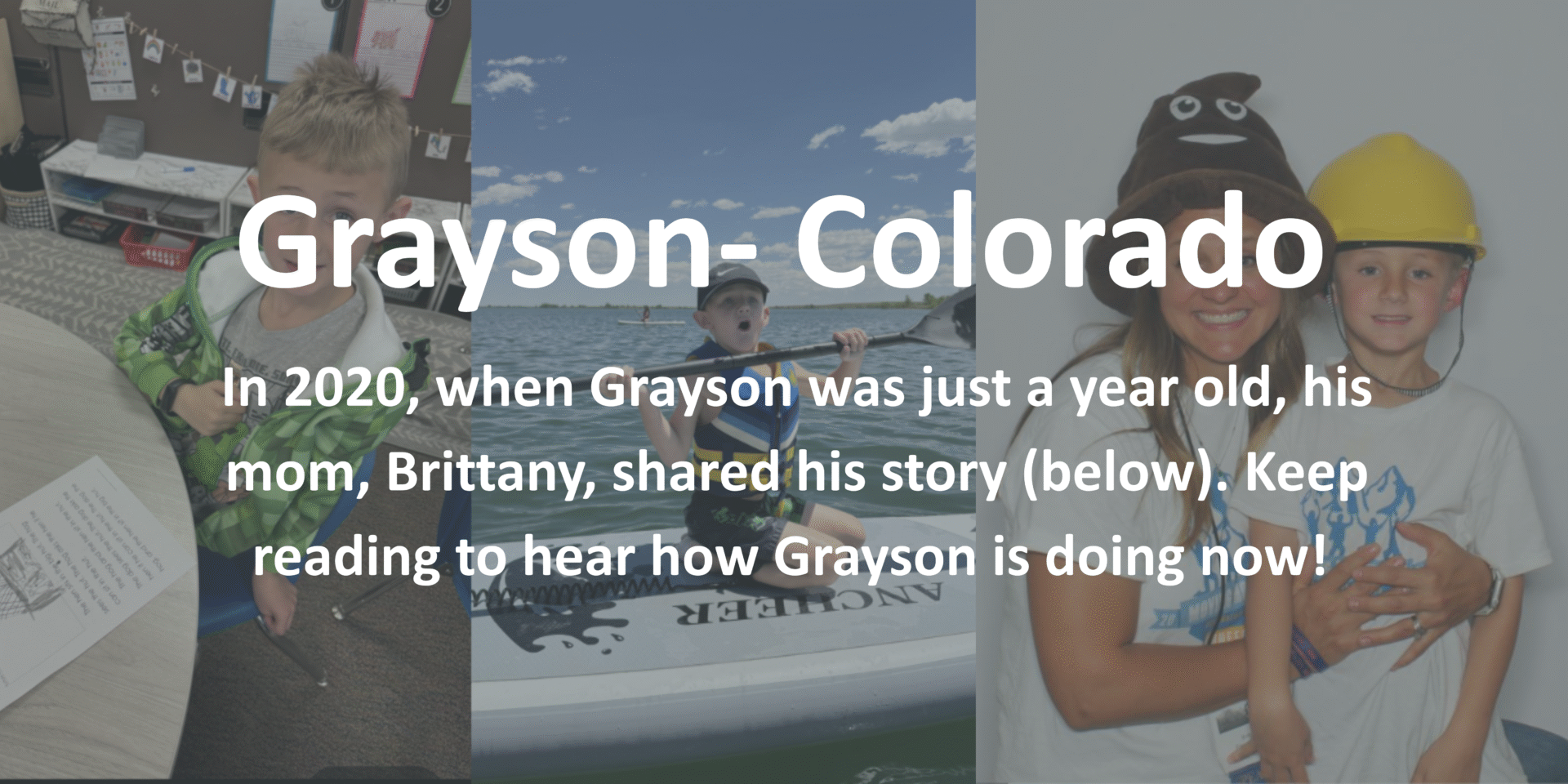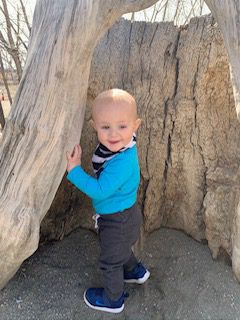
It’s been a few years since we updated the community on Grayson’s progress. I like to think this is a ‘where is he now’ story! We previously shared our journey to a diagnosis, which was long and had many trials and grief. As a family, we have been learning for the last 6 years how to live and cope with his diagnosis and make the best out of our circumstances. One of our goals is to help him understand his diagnosis, normalize it, and make sure he doesn’t feel different than other kids his age.
The transition to kindergarten last year was difficult...for me, not him. It was the first time someone else would be giving him his medication outside of our immediate family. It required a great deal of patience and trust. I am so grateful to his school because they did fantastically! He didn’t have any issues the entire year taking his medication. He got into a routine. After finishing his lunch, he would walk to the front office and take his medication. By the time he finished, his class was usually lining up and walking back to the room, so he would just jump back in line. Most of the class had no idea he was even gone or that he had to take daily medication. Grayson prefers it that way; he doesn’t like people knowing and prefers to just take it and get back to life. He started kindergarten with an IEP for speech services and halfway through the year had met all his goals and was discharged from services. He completed the rest of the year without any support and excelled! He made lots of friends, learned how to read, write, and sit still (although that skill is mostly reserved for school, not home).
Grayson is now 6 years old and about to start first grade at our local elementary school. He has spent the summer doing all the activities he loves: riding his bike, swimming at the pool, paddleboarding, playing at the park, and hanging out with friends. His big accomplishment this summer was participating in the local kids' triathlon with his big sister Riley. He swam 25 meters, rode his bike ½ mile, and ran ½ mile. He’s super excited for this year's HCU Race for Research because it is wizard-themed, and he is a huge fan of Harry Potter. It’s been a great experience for our family to participate together and raise funds for research



He also played tee ball this summer and liked hitting the ball way more than standing in the outfield waiting to catch a ball. We often had to tell him to stop playing in the dirt, as a ball would roll right by him. His goofy personality has emerged more recently, and we love his carefree, fun attitude. He loves to elicit laughs from his sisters and can often be seen making silly faces, dancing like a monkey, or singing songs loudly to himself.
There are certainly still struggles which snap me back to reality and help me remember just how grateful I am for the HCU community. I think the biggest support since he was born has been attending the in-person family conferences. We have attended two conferences, and they have been life-changing for our whole family. Grayson was able to meet and make friends with kids just like him. Our daughters have met other siblings and had their feelings validated and seen. It was hard for our two girls when Grayson was born because a lot of our time and energy went to his management and treatment. They didn’t complain because they love their brother and wanted the best for him, but at the same time I know they felt ignored. Robert and I were able to connect with other parents and share our struggles and successes. It’s been so exciting seeing how our community is growing and all the improvements in research. We will for sure be at the family conference in 2026 and can’t wait to see all our friends and make new ones!


Grayson has been in play therapy since he was 2 years old with a clinic that specializes in working with kids who have chronic health conditions. They have worked with him to help him understand his medical needs and the importance of taking care of himself. It has also been a great place for him to express himself and his feelings.
I think the biggest lesson we have learned is to take each day as it comes. We recognize the grief that we have over many losses, but fill it with action. As a family, we openly talk about his diagnosis and advocate for a better future for him. I’m so proud of him and grateful for the purpose he has given me in my life. I see the story of his life and the journey our family has had, opening doors to improve the lives of other children.
I owe a huge debt of gratitude to the metabolic team in Colorado, who have taken such good care of him even before he was born. I truly believe the success and growth he has had are due to his early diagnosis and treatment. His doctors keep up to date on recent publications and are always willing to listen to my ideas or concerns. Sharing his story is hard because it brings with it a lot of feelings; however, the positive outcomes from others hearing our journey far outweigh any negatives. I would encourage you all to share your journey and actively be a part of the HCU community.
2020 Story-
My name is Brittany, and I live with my husband, Robert, and three children in Colorado. My family’s journey into the rare disease community began suddenly and without warning almost nine years ago. We were living on the East Coast and had just given birth to our second child and first son.
Drew was born on a beautiful spring day, May 18, 2011. We welcomed him into our lives with all the love a child could possibly experience. To us he was perfect. However, as the days and weeks progressed, we began to grow concerned about certain things we noticed in his development. We frequently shared these concerns with our pediatrician only to be told that our concerns were invalid and that there was nothing wrong with our son.
Our whole world changed just a few days after his 2 month well child visit when Drew had his first life-threatening seizure. This episode caused him to stop breathing altogether due to the stress on his little body. I performed CPR on him in a desperate attempt to keep him alive until the ambulance could arrive. He was rushed to the emergency room of the local hospital, but once again, our concerns were dismissed and the doctors told us that he must have simply had acid reflux.
Less than a week after being discharged, Drew suffered another seizure again requiring CPR to stay alive until an ambulance could arrive. Unbelievably, and in spite of our adamant insistence to the contrary, doctors continued to believe that acid reflux was the cause. As a result, they kept him overnight only for observation but did not insert an IV, a choice that almost cost him his life. The following morning Drew experienced yet another seizure, but because he didn’t have an IV, there was no way for doctors to administer life-saving medication to quickly control his seizure. It took a team of doctors to resuscitate my son. Finally, the doctors began to listen to our concerns.
What ensued thereafter was three long weeks in the Pediatric ICU involving MRI’s, EEG’s, NG and G tubes, multiple spinal cord taps, countless blood draws and eventually having to be placed on a ventilator to stay alive. Despite all of these efforts, the stress on his little body became too much. Drew passed away on August 27th 2011 at the age of 3 ½ months. He had suffered severe brain atrophy caused by an undiagnosed ultra-rare metabolic disorder. His life lasted for 100 days…2,402 hours and then he was gone.
Nearly two full years after Drew’s death, and after multiple genetic tests and thousands of dollars in testing costs, we finally discovered that our son had been affected by a disorder known as Homocystinuria caused by a Cobalamin defect. However, we still had no way of knowing what sub-type of this disorder had taken his life.

It wasn’t until seven years later in March of 2019 that we were finally given a definitive diagnosis: Homocystinuria with a Cobalamin G defect. We received this knowledge because we gave birth to our fourth child and second son, Grayson, who suffers from the same disorder. As a result of thoughtful doctors who listened to our concerns during pregnancy and thanks to improved technology, immediately upon Grayson’s birth we were included in a research study at Children’s Hospital Colorado that shortened the genetic testing turnaround time from twelve weeks to three days and provided the results that we had sought for so long. Finally we were given answers that could explain why our son had died eight years earlier. These same answers provided a roadmap for how to treat Grayson so his outcome would be better than Drew’s. While we had previous knowledge of a genetic mutation for CblG that I was a recessive carrier for, we were told that the mutation that my husband carries is a novel mutation (which is why earlier testing did not detect it). Dr. Rosenblatt in Canada confirmed the diagnosis just a few months after Grayson was born.
Homocystinuria is a genetic metabolic disorder that causes toxic levels of the amino acid Homocysteine to build up in the blood and urine. When Homocystinuria is caused by a cobalamin defect, the body cannot properly metabolize cobalamin, more commonly known as vitamin b12, leading to elevated levels of Homocysteine and abnormally low levels of Methionine, both of which have serious health implications. Without early treatment, Homocystinuria can cause serious, life threatening issues. Even with treatment, individuals living with this disorder may experience vision problems, seizures, developmental delays, anemia, heart disease or blood clots as well as feeding and growth problems. Early detection and treatment are critical to success in treating this disorder.
Grayson is now a year old and he has endured a weeklong stay in the NICU, an MRI, EEG, regular visits to metabolic specialists, pediatric ophthalmologists and neurologists, weekly blood draws


to check levels of amino acids, daily injections of a specialized form of B12, and three different medications and supplements taken at each meal. While the medication tastes terrible, gives him an upset stomach and causes bad acid reflux, we have had to be creative in how we administer it. We have currently discovered a miracle elixir, Sunny Delight. While the sugary drink has absolutely no nutritional value, it somehow masks the bitter, disgusting taste of the medication. For that we are grateful because it means no tears or meltdowns at meal times…for Grayson or me.
Grayson is now a year old and he has endured a weeklong stay in the NICU, an MRI, EEG, regular visits to metabolic specialists, pediatric ophthalmologists and neurologists, weekly blood draws to check levels of amino acids, daily injections of a specialized form of B12, and three different medications and supplements taken at each meal. While the medication tastes terrible, gives him an upset stomach and causes bad acid reflux, we have had to be creative in how we administer it.
We have currently discovered a miracle elixir, Sunny Delight. While the sugary drink has absolutely no nutritional value, it somehow masks the bitter, disgusting taste of the medication. For that we are grateful because it means no tears or meltdowns at meal times…for Grayson or me.

